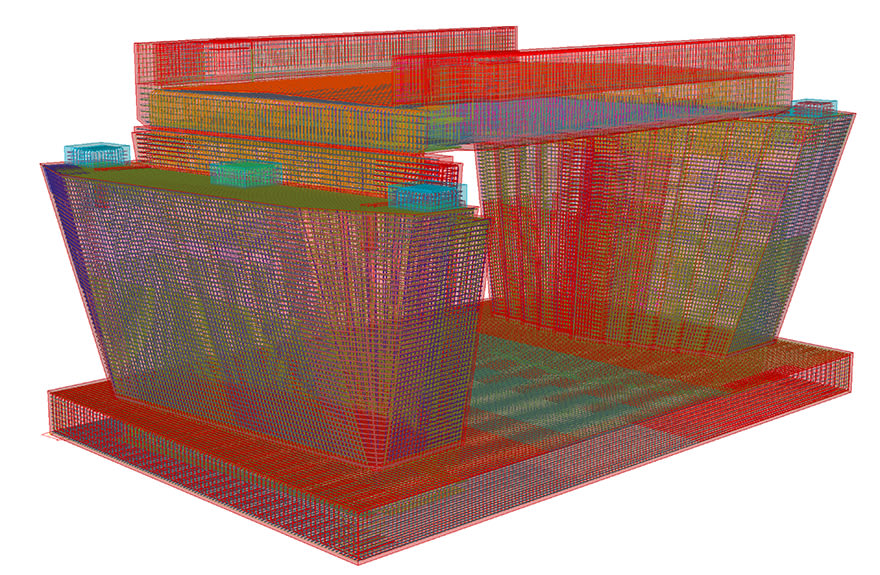- Client: Northern Hub
- Lead Contractor: Skanska/Bam JV
- BIM Tools: Tekla software
BIM 3D modelling software is helping with the structure’s design on a key project in the Northern Hub rail enhancement programme in the north west.
The Northern Hub capacity rail enhancement works is a complicated and multifaceted project. Together with the North West Electrification Programme (NWEP), it totals over £1bn of rail investment.
A key part of the programme is the Ordsall Chord, where a Skanska/Bam joint venture is the main contractor. The work includes building a new viaduct and section of railway to connect Manchester’s Victoria, Oxford Road and Piccadilly stations, and widening existing brickwork viaducts using new concrete arches.
Construction is due to get under way in the summer. In the meantime, the design is being developed by the joint venture engineering team of Aecom and Mott MacDonald. The structures are complex, comprising a mix of insitu concrete, precast concrete and steelwork. But the design is being helped enormously by BIM 3D modelling.
“Building virtual, constructable models for the requirements of stage five in the Digital Plan of Work [DPoW], before starting work on site has revolutionised the design engineering for the project,” says Brian Duguid, engineering manager for the scheme with the Aecom/Mott MacDonald JV.
“It has meant substantial benefits in terms of reducing risk of errors, increasing design accuracy, and providing better information for the construction team – and this is all before building work actually commences.”
The project delivery team set out from the start to build a common BIM model, for use both during construction and for future asset maintenance. The civil engineering design team selected Tekla Structures to create the 3D model.
One area where the model has helped particularly is in the reinforcement design. “Reinforced concrete drawings are traditionally schematic in nature, typically providing information that would now be deemed suitable at stage three or four of the DPoW,” says Duguid.

The Ordsall Chord North West Bank Structure: the ability to visualise the full reinforcement cage in 3D in advance has the potential to make construction planning much more predictable
“Although easy to understand, they don’t always help contractors and reinforcement fixers to plan the sequence of their work accurately, especially on complex structures. They also provide limited information on how reinforcement should be arranged in tight locations with limited tolerances. So being able to visualise the full reinforcement cage in 3D, using information from stage five of the DPoW, will potentially make it much easier to plan the construction.”
The modelling capabilities are crucial on the Ordsall Chord, as the widening of the existing brick-arched viaduct involves 25 varying concrete arches in total. Every new arch will have a different geometry as a result; the taper of the concrete widening and the demanding architectural parameters means that no two arches are the same.
“A key feature of Tekla 3D modelling software is that any changes made to the model during stages three, four and five of the DPoW can be fed through into updated 2D drawings and reinforcement bar schedules with a minimum of manual intervention,” explains Duguid. “With a large number of parties involved in the project, being able to quickly respond to changes and revisualise the reinforced concrete works will be very helpful.”
Another complication on the project is the amount of structural steelwork hidden within the reinforced concrete.
“The Tekla software allowed us to detail this steelwork and reinforcement, which was invaluable,” says Duguid. “It provided the opportunity to identify any potential glitches and clashes, and see how everything will fit together before the steelwork is fabricated off site. This will greatly reduce problems out on site and prevent substantial delays and cost.”
He continues: “Fully developed stage five BIM data provides enhanced reassurance and confidence to all parties involved, especially on a project like this with multiple subcontract suppliers, all of whose work must fit together perfectly.
For example, there are precast elements supported on insitu concrete, which in turn support further insitu concrete panels, as well as the instances where structural steelwork is embedded in the concrete. Those three key suppliers have a number of geometrically complex interfaces.
“The use of Tekla software for coordination throughout the design, planning and delivery phases has improved accuracy and greatly reduced the likelihood of unexpected clashes.”
Main image: The Ordsall Chord provides a new viaduct and section of railway to connect Manchester’s Victoria, Oxford Road and Piccadilly stations
Building virtual, constructable models for the requirements of stage five in the Digital Plan of Work has meant substantial benefits in terms of reducing risk of errors, increasing design accuracy, and providing better information for the construction team.– Brian Duguid, Aecom/Mott MacDonald JV











